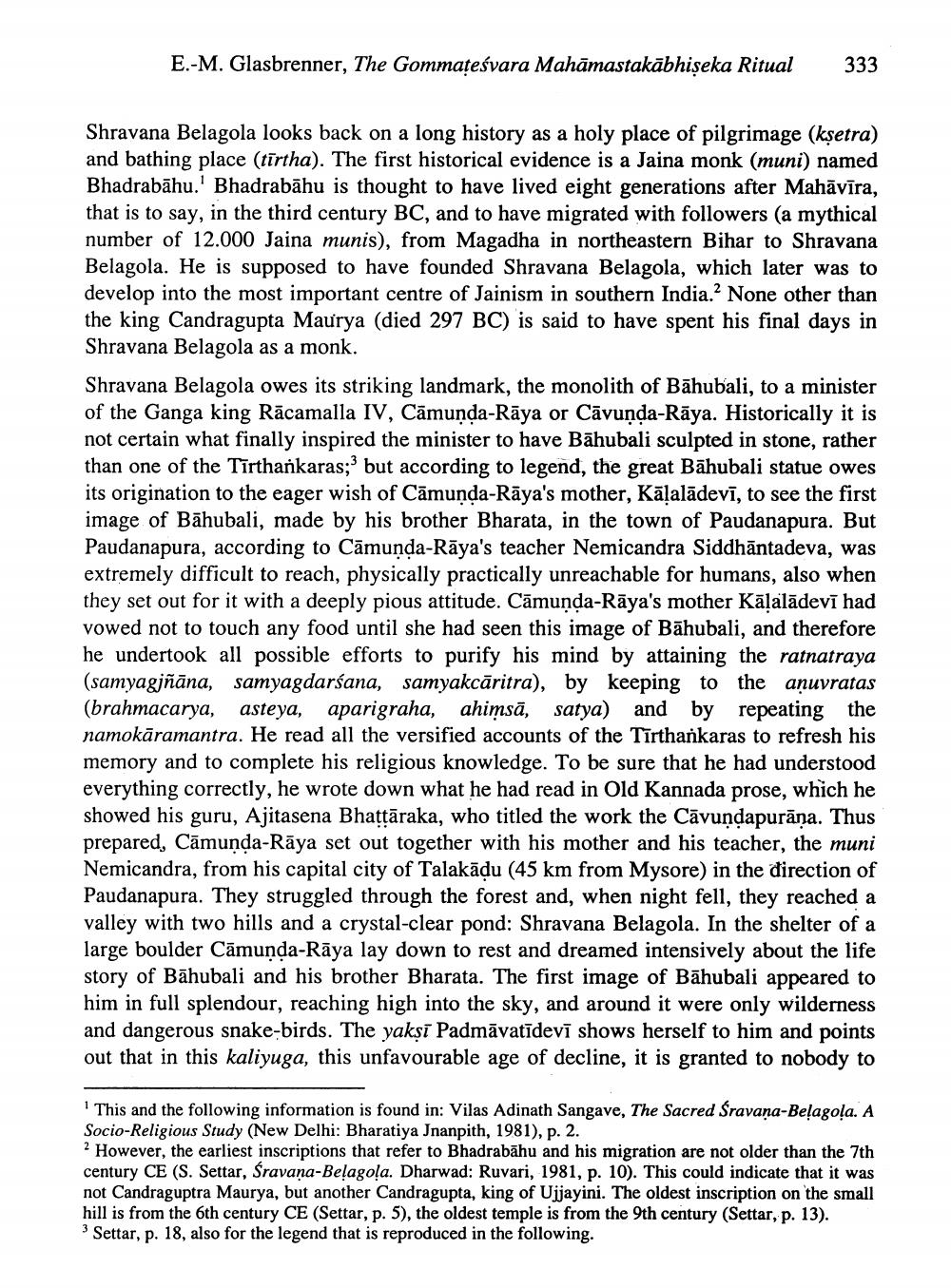________________
E.-M. Glasbrenner, The Gommateśvara Mahāmastakābhiseka Ritual
333
Shravana Belagola looks back on a long history as a holy place of pilgrimage (kşetra) and bathing place (tīrtha). The first historical evidence is a Jaina monk (muni) named Bhadrabāhu.' Bhadrabāhu is thought to have lived eight generations after Mahāvīra, that is to say, in the third century BC, and to have migrated with followers (a mythical number of 12.000 Jaina munis), from Magadha in northeastern Bihar to Shravana Belagola. He is supposed to have founded Shravana Belagola, which later was to develop into the most important centre of Jainism in southern India. None other than the king Candragupta Maurya (died 297 BC) is said to have spent his final days in Shravana Belagola as a monk. Shravana Belagola owes its striking landmark, the monolith of Bāhubali, to a minister of the Ganga king Rācamalla IV, Cāmunda-Rāya or Cāvunda-Rāya. Historically it is not certain what finally inspired the minister to have Bāhubali sculpted in stone, rather than one of the Tīrthankaras;} but according to legend, the great Bāhubali statue owes its origination to the eager wish of Cāmunda-Rāya's mother, Kāļalādevī, to see the first image of Bāhubali, made by his brother Bharata, in the town of Paudanapura. But Paudanapura, according to Cāmunda-Rāya's teacher Nemicandra Siddhāntadeva, was extremely difficult to reach, physically practically unreachable for humans, also when they set out for it with a deeply pious attitude. Cāmunda-Rāya's mother Kālalādevī had vowed not to touch any food until she had seen this image of Bāhubali, and therefore he undertook all possible efforts to purify his mind by attaining the ratnatraya (samyagjñāna, samyagdarśana, samyakcāritra), by keeping to the anuvratas (brahmacarya, asteya, aparigraha, ahimsā, satya) and by repeating the namokāramantra. He read all the versified accounts of the Tīrthankaras to refresh his memory and to complete his religious knowledge. To be sure that he had understood everything correctly, he wrote down what he had read in Old Kannada prose, which he showed his guru, Ajitasena Bhattāraka, who titled the work the Cāvundapurāna. Thus prepared, Cāmunda-Rāya set out together with his mother and his teacher, the muni Nemicandra, from his capital city of Talakādu (45 km from Mysore) in the direction of Paudanapura. They struggled through the forest and, when night fell, they reached a valley with two hills and a crystal-clear pond: Shravana Belagola. In the shelter of a large boulder Cāmunda-Rāya lay down to rest and dreamed intensively about the life story of Bāhubali and his brother Bharata. The first image of Bāhubali appeared to him in full splendour, reaching high into the sky, and around it were only wilderness and dangerous snake-birds. The yakși Padmāvatīdevī shows herself to him and points out that in this kaliyuga, this unfavourable age of decline, it is granted to nobody to
This and the following information is found in: Vilas Adinath Sangave, The Sacred Sravaņa-Belagola. A Socio-Religious Study (New Delhi: Bharatiya Jnanpith, 1981), p. 2. 2 However, the earliest inscriptions that refer to Bhadrabāhu and his migration are not older than the 7th century CE (S. Settar, Sravana-Belagoļa. Dharwad: Ruvari, 1981, p. 10). This could indicate that it was not Candraguptra Maurya, but another Candragupta, king of Ujjayini. The oldest inscription on the small hill is from the 6th century CE (Settar, p. 5), the oldest temple is from the 9th century (Settar, p. 13).
Settar, p. 18, also for the legend that is reproduced in the following.




